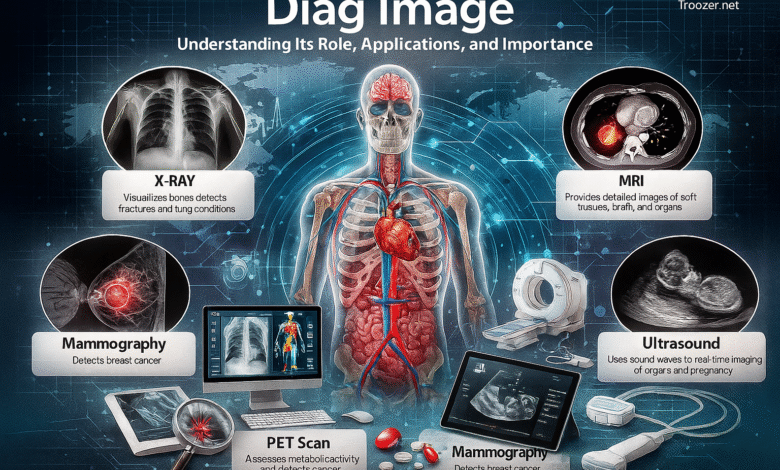Diag Image: Understanding Its Role, Applications, and Importance

The digital age, the term diag image has become increasingly relevant in fields such as technology, medicine, automotive repair, and even design. While the phrase may sound abstract, it essentially refers to a diagnostic image—a visual representation created to analyze, troubleshoot, or understand complex systems, processes, or conditions. Whether in a medical scan, a computer system log, or a schematic diagram of machinery, diag images are indispensable tools for identifying issues, interpreting data, and guiding solutions.
What Is a Diag Image?
At its core, a diag image is a visual aid used for diagnostics. It can be:
-
A medical diagnostic scan such as an MRI, CT scan, or X-ray image.
-
A computer-generated diagnostic image, like a screenshot of error codes, system activity, or a graphical visualization of data.
-
An engineering or automotive diagnostic diagram, helping technicians detect issues within machines or vehicles.
-
A design-related diagnostic schematic, often used in technical fields to troubleshoot electronics or circuits.
The key function of a diag image is not simply to display information, but to translate complex systems into visual formats that make problem-solving easier.
Applications of Diag Image in Medicine
One of the most widely recognized uses of diag images is in healthcare diagnostics. Medical imaging technologies generate visual data that doctors and specialists analyze to detect conditions that may not be visible externally.
Common Types of Medical Diag Images:
-
X-Rays – Used for identifying fractures, dental issues, and certain infections.
-
CT Scans (Computed Tomography) – Provide cross-sectional views of the body, useful for detecting tumors or internal injuries.
-
MRI (Magnetic Resonance Imaging) – Detailed soft tissue images that help diagnose neurological and musculoskeletal conditions.
-
Ultrasound Images – Widely used in prenatal care, as well as in cardiology and abdominal diagnostics.
In this context, diag images support early detection, accurate diagnosis, and effective treatment planning. Without such visual aids, modern medicine would lose much of its precision.
Diag Images in Technology and Computing
Outside of healthcare, diag images play a vital role in the IT sector. System administrators, software engineers, and cybersecurity experts often rely on visual diagnostic tools to understand errors, monitor performance, and troubleshoot issues.
Examples include:
-
System Diagnostic Screenshots – Capturing error codes, memory usage, or crash details for further analysis.
-
Graphical Diagnostic Tools – Software like performance monitors and network diagnostic applications generate images of traffic, latency, and CPU/GPU usage.
-
Disk and Partition Diagnostic Images – Used in computer recovery, where disk imaging software creates a full diagnostic copy of data for analysis and backup.
In technology, diag images serve as a bridge between raw data and human comprehension, making them indispensable for effective problem-solving.
Automotive and Engineering Applications
In automotive repair, diag images are frequently used by technicians. Modern vehicles are equipped with onboard diagnostics (OBD) systems that generate codes and, in some cases, visual diagnostic charts or images.
-
Engine Diagnostics – Visual readouts of engine performance, fuel efficiency, and error codes.
-
Electrical Systems – Wiring diagrams and diagnostic schematics that help identify faults.
-
Mechanical Schematics – Exploded diagrams of car parts, showing how components fit and function.
Similarly, in engineering disciplines, diag images are used to simplify complex technical information into schematics, flowcharts, and visual breakdowns that assist with repairs, testing, and innovation.
Why Diag Images Are Essential
The importance of diag images lies in their ability to:
-
Simplify Complexity – Translating intricate processes into visuals that are easier to interpret.
-
Improve Accuracy – Reducing the chances of error in diagnostics by providing clear evidence.
-
Enhance Communication – Serving as a common reference point between experts, technicians, and clients.
-
Save Time and Costs – Allowing faster problem identification and reducing the need for trial-and-error approaches.
-
Aid in Education – Providing learners and professionals with visual references for better understanding.
Challenges Associated with Diag Images
While diag images are powerful tools, they also come with challenges:
-
Interpretation Errors – A medical scan or technical schematic is only as useful as the expert analyzing it.
-
Data Overload – In fields like IT, diagnostic images can contain too much information, making it difficult to isolate the problem.
-
Dependence on Technology – Many diag images require advanced equipment or software, which may not be universally accessible.
-
Privacy and Security – Particularly in medicine and IT, diag images often contain sensitive data that must be protected.
Future of Diag Images
With advances in artificial intelligence (AI), machine learning, and 3D visualization, diag images are evolving rapidly. For instance:
-
In medicine, AI-powered imaging can detect early signs of disease with higher accuracy than humans.
-
In technology, predictive diagnostics can visualize system failures before they occur.
-
In automotive and engineering, augmented reality (AR) diag images are being used to overlay repair instructions directly onto physical machinery.
This suggests that diag images will not only remain relevant but also become more intelligent, interactive, and widely adopted.
Read More: Grouse Cheese: A Rare Culinary Concept Bridging Game and Dairy
Conclusion
The concept of a diag image spans across multiple industries, from healthcare and IT to automotive repair and engineering. At its essence, it is a visual diagnostic tool that transforms raw data or complex systems into an understandable format. By making the invisible visible, diag images empower professionals to make better decisions, solve problems faster, and reduce risks.
As technology advances, the role of diag images will only grow more sophisticated—helping humanity understand and navigate an increasingly complex world.



